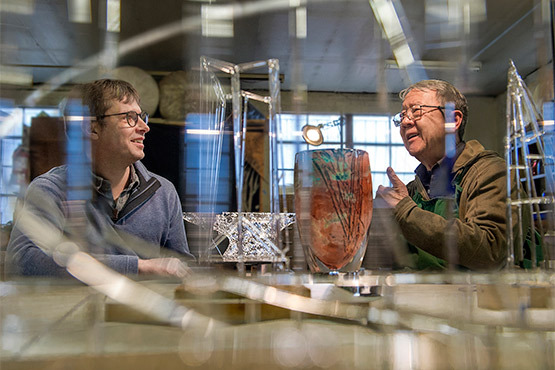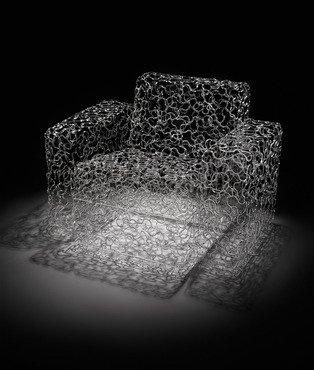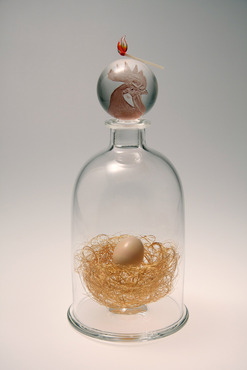
News . Feature Stories . Young ignited the torch, Petrovic carries it forward
News
February 18, 2016
Young ignited the torch, Petrovic carries it forward
Glass department relies on core artistry

Marc Petrovic, left, and Brent Kee Young in Young's studio. "It's not what you do with the material," Young told his students. "It's what you can bring to the material somewhere from the outside."
By Karen Sandstrom
Brent Kee Young remembers a few things about Marc Petrovic from the late ’80s, when Young, the teacher, first met Petrovic, a student making his first forays into glassmaking.
“He was messy. He needed a lot of space. He would take over spaces,” Young says with a bit of playfulness in his voice. Then he gets more serious. “He worked very hard, right from the get-go.”
Young is draped in a workshop apron in his Perkins Ave. studio, where he toils on an anvil that he is building out of a web of clear glass rods – part of his Matrix series. Petrovic (’91), who has joined him on a break from teaching at CIA, has early memories of his own. One of them was how mesmerized he felt, as a freshman and sophomore visiting the faculty art show, by examples of vessels Young had made that contained what looked like fossilized clay (they were actually all glass).
“These were the pieces in the faculty show that made me want to [make glass],” Petrovic says.
In fall of 2014, Petrovic took over as head of the Cleveland Institute of Art’s glass department. He inherited the mantle from Young, now professor emeritus, who started the program in 1973 and ran it until his retirement in spring 2014. With that change, Petrovic accepted leadership of a department that has produced scores of celebrated artists whose work appears in galleries, museums and private collections.
Petrovic made a few changes right away, like cleaning up and rearranging the physical environment of the glass department. He bought a trio of heat shields to make working at the furnaces more comfortable. He added eight new fusing and slumping kilns to support expanded curriculum. And the studio now has a new flame-working kiln and a six-station stainless steel flame-working island to support an expanded flame-working curriculum.
But Petrovic is carrying forward core values he and Young believe have allowed so many CIA glass graduates to produce high level work. First comes rigorous exploration of materials — lots of hours invested in developing craftsmanship and an understanding of how glass behaves.
“For me, the fascination with that material kind of begins in the hot shop because you come to a real visceral understanding of how the material works,” Young says.
Petrovic agrees. In addition to his CIA education, he earned part of that understanding as a student working summers at Cedar Point, blowing glass and talking about it to folks seeking shelter from sun or rain. “That was huge, because it gave me six days a week of blowing glass whether I wanted to or not,” he says.
Petrovic gradually grew more comfortable with the physical process, which allowed him freedom to think about what he really wanted to make. “When you’re first starting out, you’re so worried about making a perfect sphere that going in and willingly mangling it is a high risk proposition,” Petrovic says.
But glass itself – molten, malleable, texturally changeable – isn’t what makes great art.
Young says he has always tried to explain to students that “it’s not what you do with the material, it’s what you can bring to the material somewhere from the outside – some other kind of experience.”
Petrovic agrees. His goal for students is not to send them out into the world with a bag full of glassmaking tricks. “I keep telling them that all those people out there who you admire, whose work you admire, they aren’t regurgitating what they were taught,” he says. “They’re taking what they were taught and doing something new with it.”
Young and Petrovic both mentioned the influence of longtime CIA faculty member Richard Fiorelli – colleague and friend to Young, and an influential design teacher to Petrovic back in the ’80s.
“Richard and I talk about digging a hole, and being insecure and creating a situation where you don’t know what you’re doing,” Young says. “The more times you find some kind of success in digging your way out of that hole, the more comfortable you become in being uncomfortable.”
“That’s where original work comes from,” Petrovic says.
Now a sampling of that that kind of work is on view at the Mansfield Art Center in an exhibition titled “The Glass Matrix: The Cleveland Connection. It showcases Young’s delicate-feeling clear glass sculptures along with works by 11 other northern Ohio students who came through his program. Petrovic (’91) and his wife, Kari Russell-Pool (’90) are two.
The others: Carrie Battista (’06); Robert Coby (’11), Scott Goss (’06); Earl O. James (’88); Brent Marshall (’83); Shawn Messenger (’79); Michael Mikula (’87); Mark Sudduth (’83) and Linda Zmina (’89).
The exhibition fills 5,000 square feet of gallery space, and it has been tremendously popular, says George Whitten, executive director of the art center. “People have been pouring in here, even on Super Bowl Sunday,” Whitten says.
Among the memorable comments from a visitor: “Well, you didn’t have any Dale Chihuly,” Whitten says, “but you didn’t need him.”
The Glass Matrix: The Cleveland Connection will be on view through March 6 at the Mansfield Art Center, 700 Marion Avenue, Mansfield, OH.
Latest Headlines view all
-
April 02, 2024
Cleveland Institute of Art students partner with Progressive Art Collection to exhibit Ready, Set, Relay! -
March 04, 2024
Cleveland Institute of Art announces Curlee Raven Holton Inclusion Scholar Program -
November 06, 2023
Collision of art and artificial intelligence creates murky waters for artists, curators and educators
Questions?
For more information about this or other CIA news, contact us here.



Social Feed